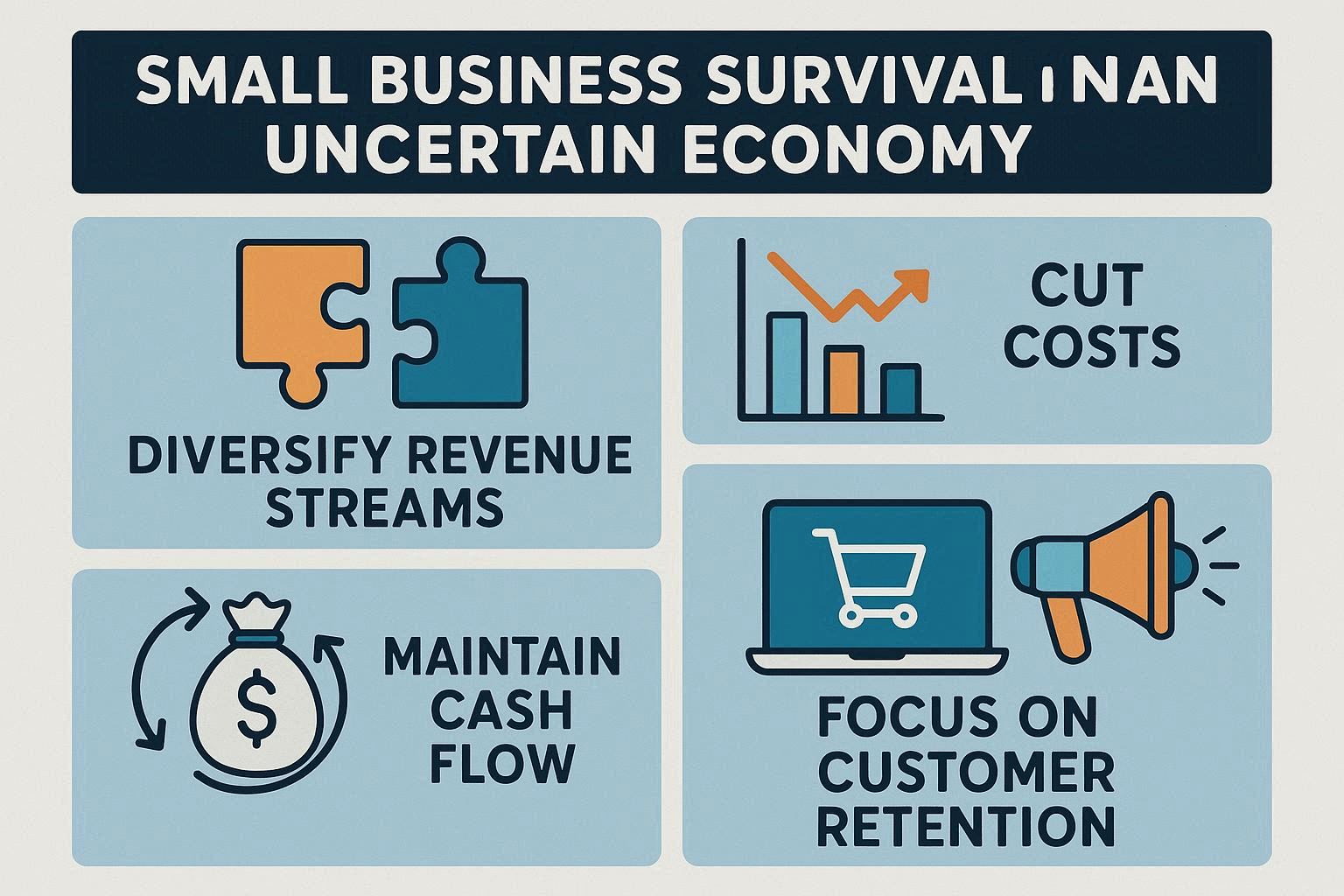Running a small business has never been easy, but in today’s uncertain global economy, entrepreneurs face more challenges than ever before. Inflation, shifting consumer behaviors, technological disruption, and unpredictable market conditions make survival and growth a daily balancing act. Yet, many small businesses are not only surviving—they are thriving by embracing new strategies, leveraging technology, and staying adaptable.
This article explores practical survival strategies for small businesses in an uncertain economy, focusing on cost management, digital transformation, customer loyalty, and long-term resilience.
1. Understanding Today’s Economic Challenges
Before crafting strategies, small businesses must understand the realities shaping the economy in 2025. Key challenges include:
- Rising Costs: Inflation drives up expenses for raw materials, energy, and logistics.
- Uncertain Demand: Shifts in consumer confidence and spending habits make forecasting difficult.
- Competition: Both local competitors and global e-commerce giants create pressure on pricing and differentiation.
- Technology Disruption: Businesses that fail to adopt digital tools risk falling behind competitors that operate faster and more efficiently.
- Labor Challenges: Retaining skilled employees remains difficult amid global workforce shifts and rising wages.
2. Cost Optimization Without Cutting Corners
Managing expenses is critical for survival, but cost-cutting should not compromise quality or customer experience. Instead, businesses should focus on smarter resource allocation.
2.1 Streamline Operations – Automating repetitive tasks such as invoicing, scheduling, and payroll reduces labor costs and minimizes errors.
2.2 Negotiate with Suppliers – Long-term partnerships and bulk purchasing can secure better pricing. Exploring local suppliers also reduces shipping costs and supply chain risks.
2.3 Monitor Cash Flow – Regularly reviewing cash inflows and outflows ensures businesses can act quickly when expenses rise or revenue slows.
2.4 Outsource Non-Core Tasks – Hiring freelancers or agencies for tasks like marketing or IT support can be more affordable than maintaining full-time staff.
3. Diversifying Revenue Streams
One of the biggest risks for small businesses is relying too heavily on a single product, service, or customer group. Diversification builds resilience.
3.1 Add Complementary Products or Services – For example, a coffee shop can sell packaged beans, brewing equipment, or branded merchandise.
3.2 Explore Digital Channels – Selling products online, offering virtual consultations, or creating digital courses provides additional revenue streams.
3.3 Subscription Models – Subscriptions create predictable income and strengthen customer loyalty. Even small businesses can offer memberships or recurring services.
3.4 Partnerships and Collaborations – Partnering with other small businesses expands reach and introduces services to new customer bases.
4. Embracing Digital Transformation
Digital adoption is no longer optional—it is a survival necessity. Small businesses that embrace technology increase efficiency, visibility, and competitiveness.
4.1 E-commerce and Online Presence – Even brick-and-mortar stores need websites and social media to attract customers and build trust.
4.2 Digital Payments – Offering multiple payment options, including mobile wallets and contactless transactions, enhances customer convenience.
4.3 Data-Driven Decisions – Affordable analytics tools help businesses understand customer behavior, track sales trends, and make smarter marketing investments.
4.4 Cloud-Based Tools – Using cloud accounting, project management, and collaboration platforms reduces costs while improving accessibility.
5. Building Customer Loyalty
In uncertain economies, retaining customers is more cost-effective than constantly acquiring new ones. Loyalty becomes a competitive advantage.
5.1 Exceptional Customer Service – Personalized interactions and quick problem resolution create long-lasting trust.
5.2 Loyalty Programs – Rewarding repeat customers with discounts, points, or exclusive offers encourages continued business.
5.3 Customer Feedback Loops – Actively listening to customers and implementing their feedback demonstrates commitment to continuous improvement.
5.4 Community Engagement – Supporting local initiatives or participating in community events strengthens the bond between businesses and their customers.
6. Building Resilience for the Future
Small businesses must not only focus on immediate survival but also build long-term resilience to weather future uncertainties.
6.1 Financial Preparedness – Maintaining emergency funds and securing flexible credit lines provide cushions during economic downturns.
6.2 Agility and Adaptability – Businesses that can quickly adjust their strategies, pricing, or operations are better equipped to survive disruptions.
6.3 Continuous Learning – Investing in staff training and leadership development helps teams adapt to evolving market needs.
6.4 Scenario Planning – Regularly evaluating “what-if” scenarios prepares businesses for potential risks and opportunities.
6.5 Sustainable Practices – Eco-friendly operations and social responsibility enhance brand image while aligning with consumer expectations in 2025.
7. Case Studies of Small Business Resilience
Local Restaurants – Many pivoted to delivery, online ordering, and meal kits during crises, creating new income streams that remain profitable today.
Retail Shops – Small stores adopted e-commerce platforms, using social media marketing and live shopping events to engage customers globally.
Freelancers and Creatives – By leveraging online platforms and global marketplaces, many professionals expanded their reach and reduced reliance on local demand.
Conclusion
In an uncertain economy, small businesses face daunting challenges—but also significant opportunities. Success in 2025 requires adaptability, digital adoption, and a focus on building strong customer relationships. By optimizing costs, diversifying revenue, embracing technology, and planning for the long term, entrepreneurs can not only survive but thrive.
The most resilient small businesses are those that see change not as a threat but as a chance to innovate. In a world where uncertainty is the only constant, agility, creativity, and customer focus are the keys to enduring success.

